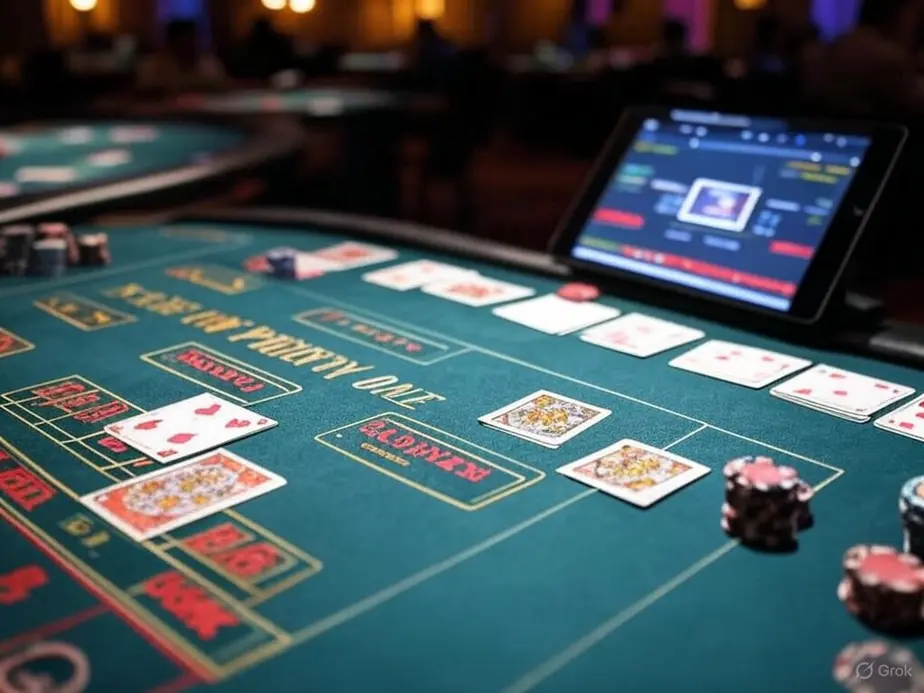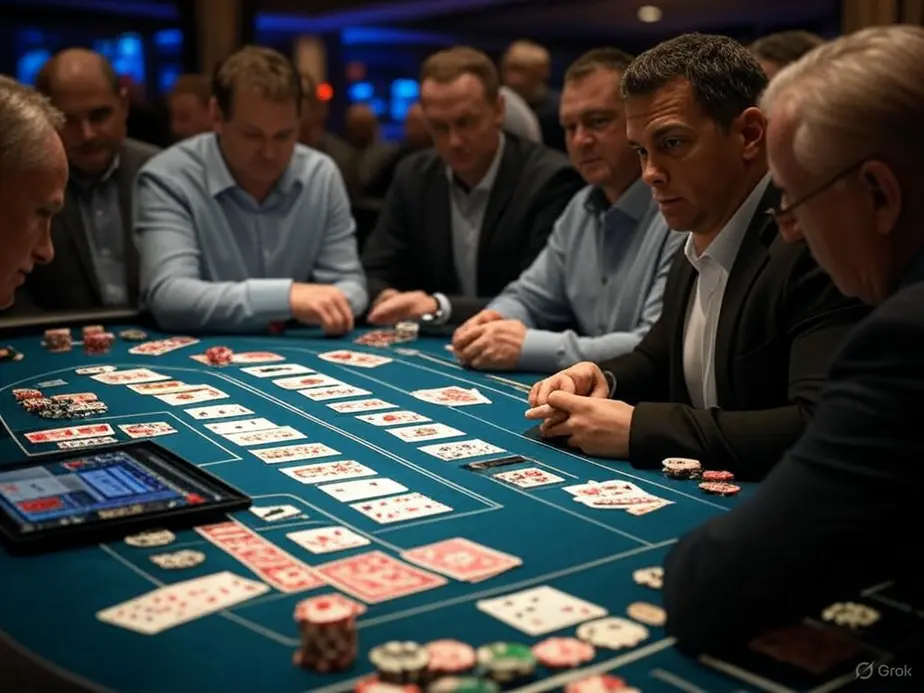Twenty-one, widely known as Blackjack, offers a dynamic blend of chance and strategy that online poker players can appreciate and learn from. This classic card game demands sharp decision-making, risk assessment, and an understanding of probability—core skills also essential in poker play. By examining the fundamental principles and tactics behind Twenty-one, poker enthusiasts can refine their strategic thinking and improve their in-game judgment. This article breaks down the essential components of Twenty-one, linking its gameplay mechanics to poker strategies. The first chapter dives deep into the game’s foundational rules and decision-making elements that resonate with poker acumen. The second chapter focuses on strategic approaches and risk management techniques transferable between Twenty-one and online poker, fostering a holistic understanding of card game mastery.
Mastering the Magic of Twenty-One: Unraveling Blackjack’s Rules and Strategic Depth
The allure of Twenty-One, most famously embodied in the casino game Blackjack, lies in its elegant simplicity paired with profound strategic depth. At its core, the game revolves around a singular, tantalizing goal: to reach a hand value as close to 21 as possible without surpassing it, all while outsmarting the dealer. This numeric pursuit, deeply embedded in the game’s identity, captivates players across smoky casino floors and digital interfaces alike. Yet, beneath this straightforward objective lies a complex web of rules, choices, and calculated risks that transform Twenty-One into a battle of wits and probabilities.
Each round of Blackjack begins with a ritual of anticipation. Players are dealt two face-up cards, while the dealer reveals one card—known as the upcard—and conceals a second, the hole card. The values are clear-cut: numbered cards carry their face value, face cards like Jacks, Queens, and Kings are worth 10 points, and the versatile Ace toggles between 1 and 11, adapting to the player’s advantage. From this starting point, a cascade of decisions unfolds. Players can hit to draw another card, hoping to inch closer to 21, or stand to preserve their current total. More daring options include doubling down, where the initial bet is doubled in exchange for just one additional card, or splitting pairs, dividing identical cards into separate hands with a matching wager. Every choice is a gamble, a dance with chance where overstepping 21 means an instant loss, or bust.
Victory in Blackjack is not merely about nearing 21 but surpassing the dealer’s hand without faltering. If a player’s total eclipses the dealer’s without busting, or if the dealer themselves exceeds 21, the win is secured. A tie, termed a push, results in no exchange of bets, preserving the status quo. Yet, the game offers a coveted pinnacle: a natural Blackjack, achieved with an Ace and a ten-value card on the initial deal. This instant triumph typically pays out at 3:2 odds, though variations exist, underscoring the thrill of a perfect start. The dealer, bound by rigid rules, must hit on totals below 17 and stand at 17 or above in most formats, offering players a predictable foil against which to strategize.
The true heartbeat of Twenty-One, however, pulses in its decision dynamics. Every move hinges on probability, a delicate balance of risk and reward. Basic strategy charts serve as a lifeline for newcomers and veterans alike, distilling countless simulations into clear directives: when to hit, stand, double, or split based on the player’s hand and the dealer’s visible card. These guidelines minimize the house edge, turning a game of luck into one of informed precision. Beyond this foundation, seasoned players delve into nuanced tactics, managing their bankroll with iron discipline to weather inevitable losses. The specter of advanced techniques, like tracking high and low cards to gauge deck favorability, looms for the ambitious, though such methods carry ethical and practical controversies in casino settings.
Blackjack’s landscape is further enriched by its many incarnations. American variants grant the dealer an early hole card and offer insurance bets against a potential dealer Blackjack, while European rules delay the hole card reveal, heightening suspense. Other versions, like Pontoon, weave in unique terminology and multi-deck intricacies, each twist subtly altering the strategic calculus. Online platforms amplify this diversity, delivering live-dealer experiences that mirror physical tables while slashing entry barriers with lower minimum bets. These digital arenas invite players to hone their craft from anywhere, blending convenience with the game’s timeless challenge.
Ultimately, mastering Twenty-One demands more than memorizing rules or mimicking strategy charts. It requires an intuitive grasp of risk, a willingness to adapt to variant-specific quirks, and an unwavering focus on long-term play over short-term gains. As players navigate this numeric quest, they engage with a game that is as much about mental fortitude as it is about hitting 21. For those eager to explore deeper strategic layers, resources on Blackjack strategies and variations offer a gateway to refining one’s approach, ensuring every hand dealt is a step toward mastery. This intricate blend of chance and choice sets the stage for broader gaming insights, where tactics honed at the Blackjack table can illuminate paths in other arenas of play.
Mastering the Game: Twenty-one Tactics to Dominate Online Poker
Having explored the foundational rules and dynamics of Twenty-one in various gaming formats, we now turn to a fascinating application of its strategic principles in a seemingly different arena—online poker. The numeric goal of 21, central to games like Blackjack, mirrors the calculated risks and decision-making intricacies of poker. Both demand a sharp understanding of probabilities, disciplined resource management, and psychological acumen. By distilling twenty-one key tactics inspired by Twenty-one’s strategic essence, this chapter reveals how these concepts can elevate your online poker game, forging a path to consistent success at the virtual tables.
At the heart of both Twenty-one and online poker lies the art of balancing risk and reward. Just as a Blackjack player decides whether to hit or stand based on the dealer’s upcard and their hand’s potential, a poker player must assess whether a call, raise, or fold maximizes their edge. Start with a consistent strategy, much like adhering to a basic strategy chart in Blackjack. Define your game plan—whether tight-aggressive or loose-passive—and stick to it despite short-term swings. This mirrors the discipline of managing a hand in Twenty-one, where deviating from optimal play can erode your edge. Similarly, bankroll management is non-negotiable. Set modest stakes aligned with your funds, avoiding the temptation of high-stakes tables until your experience and capital allow it. This echoes the prudent approach of preserving chips in a tournament, akin to safeguarding your stack in poker’s early stages by playing solidly and avoiding unnecessary risks.
Understanding the math behind decisions is another parallel that binds these games. In Twenty-one, calculating the odds of busting or beating the dealer guides every move. In poker, mastering pot odds and implied odds—quickly estimating whether a call is profitable—sharpens your choices. Use mental shortcuts during fast-paced online sessions to make these calculations second nature. Beyond numbers, bet sizing in poker reflects the nuanced decisions of Twenty-one. Size your bets to extract maximum value from strong hands while keeping pots manageable with marginal ones. Overbetting can scare off opponents, just as an overly cautious Blackjack play might forfeit potential gains. Strategic aggression, such as continuation bets or selective three-bets, further pressures opponents, much like splitting pairs or doubling down in Twenty-one to seize control of a favorable situation.
Reading opponents transcends both games, akin to spotting patterns in a dealer’s limited actions or a Roblox Twenty-one player’s use of Trump cards. In online poker, identify weaker players—those who overplay hands or rarely fold—and exploit their tendencies. Since online environments often obscure player history, especially with anonymous tables, focus on general betting patterns rather than specific reads. This adaptability mirrors the tactical shifts required across Twenty-one formats, where strategies adjust to context. Equally vital is poker’s psychological dimension. Maintain composure during losing streaks, just as a Blackjack player must resist tilting after a bust. Build mental endurance to outlast opponents, recognizing that confidence and patience—waiting for the right moment to strike—are as crucial as technical skill.
Continuous improvement ties these games together, reminiscent of refining Twenty-one strategies through practice. Study professional poker insights via training platforms or by observing skilled players in action. Regularly review your sessions to spot leaks—be it poor bet sizing or emotional decisions—and address them methodically. Balance value betting with calculated bluffs, keeping opponents guessing, much like a Twenty-one player varies decisions to avoid predictability. Finally, assess risk versus reward before every major play. Does the potential gain justify the chips you’re risking? This disciplined evaluation, ingrained in Twenty-one’s core, ensures you preserve your stack while capitalizing on opportunities.
By weaving these twenty-one tactics into your online poker approach, you harness the strategic depth of Twenty-one to navigate the complexities of Texas Hold’em or other variants. Mastery demands ongoing study and practice, but this roadmap offers a robust foundation. For deeper insights into evolving poker strategies, explore more at Online Poker Evolution Strategies. As we move forward, these principles will pave the way to dissecting further intersections between gaming formats, uncovering how a singular numeric goal can shape diverse winning frameworks.
Final thoughts
The game of Twenty-one embodies a strategic depth that online poker players can use to enhance their own gameplay. From foundational rules and decision-making essentials to sophisticated risk management tactics, the core principles of Twenty-one intersect remarkably with poker strategy. The analytical skills honed through understanding card values, probability, and optimal play encourage players to approach poker with heightened precision and confidence. Ultimately, embracing Twenty-one’s tactical lessons fosters sharper judgment, better risk assessment, and improved psychological resilience. These are qualities that transcend individual games and serve as pillars for growth in any card-playing discipline. Enriching one’s online poker experience by drawing on Twenty-one insights can lead to smarter plays, more calculated risks, and a sustainable competitive advantage in the digital card table environment.
Ready to Elevate Your Gambling Experience to the Next Level? Contact www.topgamb.com today and let our expert team guide you to a more exciting betting adventure with top-notch tips and picks just for YOU! Discover your Winning Edge now!
Learn more: https://www.topgamb.com/casino-rankings/
About us
The website TopGamb.Com is a trusted online casino review and ranking site dedicated to helping users find the best online gaming options. The site provides unbiased reviews, expert rankings, and comprehensive guides to help users make informed decisions. For example, it ranks different online casinos based on factors such as their user-friendliness, variety of games, and payout rates.
























